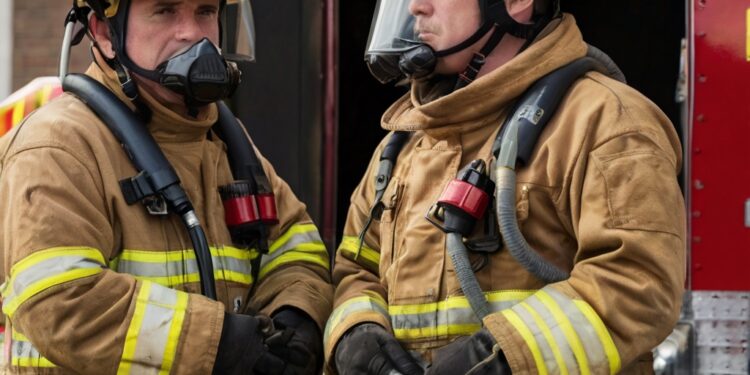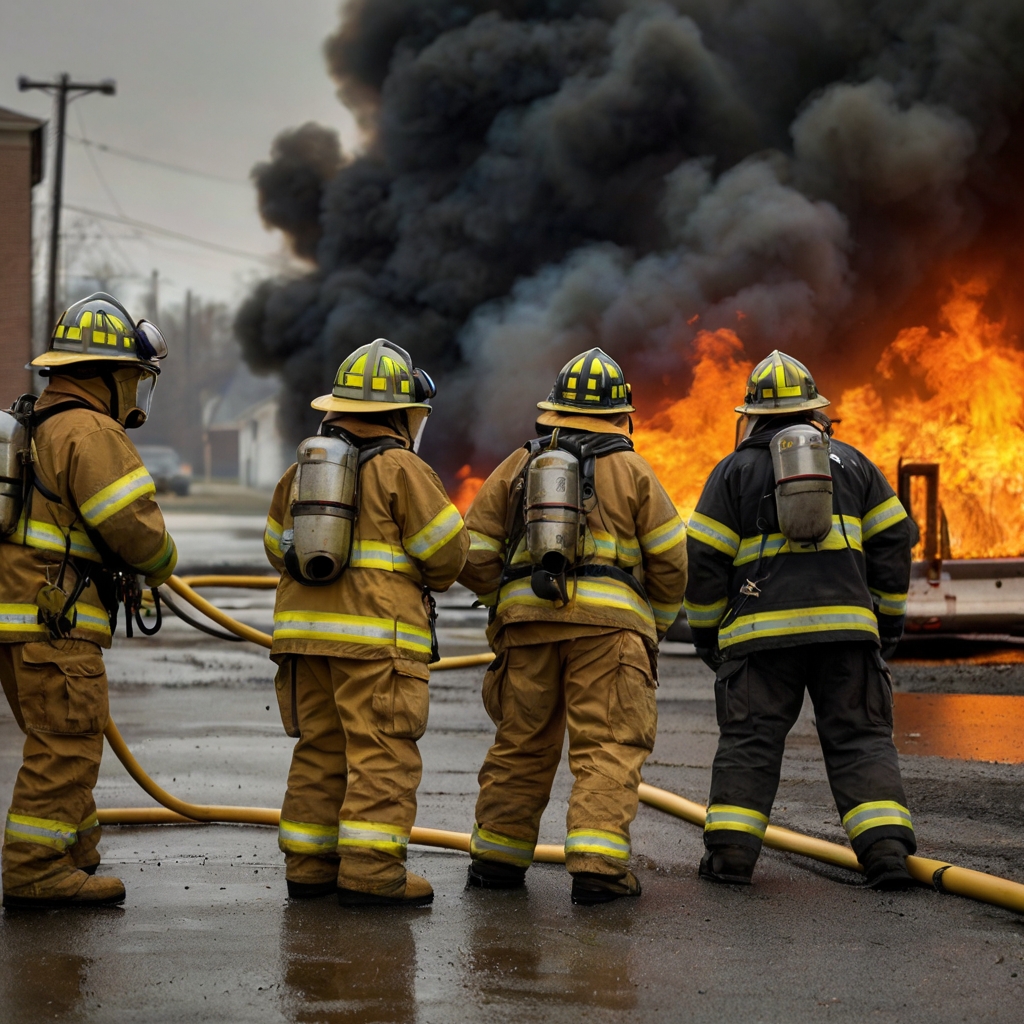Fun Firefighter Training Ideas

Fire departments nationwide face a most important challenge – training complacency that affects their emergency response readiness. Regular drills play a crucial role in a firefighter’s job, yet keeping teams enthusiastic and motivated during these sessions remains challenging.
Creative training methods can turn standard practice sessions into exciting learning opportunities. Teams can play SCBA dodgeball to improve air management skills or compete in NFPA 1410 drills between shifts. These activities help firefighters become skilled at core competencies while staying motivated.
The innovative training methods combine several skill development areas – from operating heavy rescue equipment to setting up rapid water supply systems. Fire departments can keep their teams sharp in critical areas through friendly competition and scenario-based exercises. This approach ensures proficiency in fire attack, search and rescue, and vehicle extrication while teams stay highly engaged.
Table of Contents
- 1
- 2 Why Traditional Fire Training Gets Boring
- 3 Simple Ways to Make Fire Drills Fun
- 4 Indoor Training Activities That Work
- 5 Outdoor Fire Training Ideas
- 6 How to Track Training Progress
- 7 Some FAQs about fun firefighter training ideas:
- 7.1 What does 5555 mean to firefighters?
- 7.2 What are 1410 drills?
- 7.3 What workouts should firefighters do?
- 7.4 What are the firefighting activities?
- 7.5 What does 343 mean to firefighters?
- 7.6 What is the code 4 in firefighting?
- 7.7 What are 7 on 7 drills?
- 7.8 What is the 17s drill?
- 7.9 What are the 5 battle drills?
Why Traditional Fire Training Gets Boring
Fire departments face serious problems with their training programs. Unqualified training officers who lack experience and teaching skills create these issues. This basic problem affects every part of the training process.
Common complaints from firefighters
Firefighters often feel frustrated about training sessions that don’t challenge them properly. They worry most about training officers who stick to a “my way or the highway” attitude. Some departments create an environment where firefighters stay quiet about training issues because they fear getting in trouble.
The most common training complaints include:
- Repetitive drills without clear objectives
- Limited opportunities for hands-on practice
- Training that doesn’t match ground scenarios
- Lack of constructive feedback
- Poor participation during classroom sessions
Impact on team motivation
Poor training practices do more than just make people unhappy. Many firefighters end up just going through the motions. They show up for required drills but learn only through repetition and muscle memory instead of active participation.
This passive approach makes firefighters too relaxed within their departments. However, these same members learn and behave better when they train outside their department, especially when they have non-mutual aid partners.
The motivation issue shows up clearly in departments that only train monthly and hold yearly social events. Limited involvement leads to less interest and participation. On the flip side, departments that train daily, hold weekly social events, and plan monthly outings see their teams grow stronger.
Training officers should know that motivation changes throughout a firefighter’s career. New firefighters start with excitement. The quality of training keeps them interested as routine sets in. Veteran firefighters look for chances to move up as their main motivation.
Simple Ways to Make Fire Drills Fun
Fire departments nationwide are finding new ways to boost their training programs with games and creative exercises. Escape room scenarios have become powerful tools that help develop firefighter skills.
Add friendly competition
Teams love timed evolutions as competitive drills. They race against the clock to position engines, deploy handlines and hit targets with water flow. Competition helps build skills and team spirit. Many departments use point systems and leaderboards to track progress. Top performers can win smoke detectors or gift certificates.
Include team challenges
Escape room exercises work great for building team coordination. Firefighters must:
- Solve tough problems under time pressure
- Talk clearly with team members
- Know and use each person’s strengths
- Think quickly in stressful situations
Team competitions that mirror firefighter combat challenges work well too. These events mix physical fitness with technical skills. They create fun training sessions that help teams stay ready for action.
Use training games
SCBA dodgeball has become a fun yet practical activity. Players wear full turnout gear while playing, which helps them learn air management skills naturally. Equipment games also help – like putting together nuts and bolts with gloves on after cardio workouts. This tests dexterity and focus when physically tired.
Leveling systems for specific skills work well too. Firefighters start with simple equipment handling and move up to complex operations. This clear path of progress keeps everyone engaged.
Technology plays its part in training games. Teams use audience response systems for quick quizzes about ladder company operations. This creates interactive learning with instant feedback. Tutorial videos paired with hands-on practice let firefighters review techniques before showing what they’ve learned.
These engaging methods show real results. Studies prove that adding competition pushes participants to do their best. Mixing games with practical skills keeps firefighters entertained and ready for ground emergencies.
Indoor Training Activities That Work
Fire departments can maintain their skills year-round with creative indoor training sessions, whatever the weather. These proven training methods pass down from one generation to the next. They help build technical skills and strengthen department culture.
Equipment familiarization games
Firefighters master their tools through innovative equipment drills that keep everyone engaged. Teams of two compete in the “adaptor drill” to connect different hose sizes using various adaptors. This helps them think on their feet and boosts their technical skills.
You’ll find departments coming up with unique challenges like the “egg exercise.” Firefighters use extrication tools to move delicate objects. This helps them develop the control and precision they need to rescue victims.
Rescue scenario simulations
Search and rescue simulations are the life-blood of indoor training programs. Teams create realistic emergency scenarios using thermal imaging cameras, communication protocols, and victim extraction techniques.
RIT drills focus on saving fellow firefighters who get lost, hurt, or trapped during operations. The scenarios cover:
- Quick deployment strategies
- Team communication protocols
- Specialized rescue techniques
- Emergency air supply management
- Victim extraction methods
Modern training facilities make these exercises better with advanced simulation tech. The FLAIM Trainer system creates virtual scenarios that adapt to how each trainee performs, giving them tailored learning experiences. Firefighters practice key skills like hose management, gas cooling, and foam application.
Many departments now employ the SimsUshare simulator program. It comes with 24 static, 24 dynamic, and 24 presentation video-based simulations for complete training. Instructors create realistic scenarios using local buildings, which makes training more relevant and practical.
These indoor training activities work because they combine multiple skill development opportunities in a controlled setting. Teams stay ready for real emergencies by focusing on equipment mastery and rescue operations.
Outdoor Fire Training Ideas
Firefighters get a chance to boost their skills in realistic environments through outdoor training exercises. The mix of physical challenges, practical scenarios, and team activities creates a detailed learning experience. This builds both individual and group capabilities.
Physical fitness challenges
The BLM Fire Fitness Challenge is a great way to keep firefighters ready for action. This challenge tests fitness through four basic exercises: pull-ups, push-ups, planking, and timed runs. So departments can adapt these activities to fit their needs while keeping core fitness standards.
Outdoor workout sessions usually include:
- Stair runs with equipment packs
- Battle rope exercises using fire hoses
- Box jumps utilizing fire engine platforms
- Farmer’s carries with foam pails
Studies show that outdoor exercise sessions boost energy levels and are more enjoyable than indoor workouts. Many departments now add natural elements to their training routines to create more engaging fitness programs.
Real-world scenario practice
Natural gas fire training gives firefighters hands-on experience in controlled environments. These sessions let teams practice containing and extinguishing actual gas fires under supervision. Simulated pipeline punctures and vehicle-related scenarios help crews prepare for common emergencies.
Realistic training exercises develop critical skills through ground applications. Participants learn to handle problems, distractions, and stresses like those in actual incidents. These scenarios often include:
Tactical Response Training:
- Hazardous material containment
- Vehicle extrication techniques
- High-angle rescue operations
Team building exercises
Fire service teams mainly depend on unity and coordination daily. Departments design team-building activities that match firefighting’s unique challenges while encouraging camaraderie.
The “Bucket Brigade” challenge has become a popular team-building exercise that combines old firefighting methods with modern training goals. Departments also run timed competitive drills where crews solve problems and complete various tasks to reach specific objectives.
Departments notice better communication and problem-solving among their teams after starting these outdoor training programs. These activities help teams understand chain of command and improve group dynamics. This prepares firefighters for the shared nature of emergency response.

How to Track Training Progress
Progress tracking is the life-blood of successful firefighter training programs. Fire departments that use structured monitoring systems show most important improvements in operational readiness and team performance.
Setting clear goals
The SMART goal-setting framework forms the foundations of tracking firefighter training progress. This approach will give a clear way to measure and improve training outcomes.
A well-laid-out SMART goal has these essential elements:
- Specific: Define exact training objectives and required skills
- Measurable: Include quantifiable metrics to review progress
- Attainable: Set realistic targets within the team’s capabilities
- Relevant: Arrange with department needs and firefighter roles
- Time-based: Establish clear deadlines and milestone dates
Note that departments using SMART goals report improved officer accountability and professional growth. Training officers should review their programs through end-of-course evaluations to maintain high standards.
Measuring improvement
Progress measurement needs detailed documentation and regular assessment. Tracking systems vary between departments, but successful programs focus on three key areas: training compliance, skill development, and operational readiness.
Modern tracking solutions have advanced features to monitor firefighter development. These systems help training administrators generate on-demand reports and track individual progress through detailed analytics dashboards. Departments can quickly spot areas needing attention and adjust their training approaches.
Performance evaluation methods should mix both immediate and long-term assessments. In fiscal year 2022, detailed evaluations showed that 529 students and 523 supervisors gave long-term feedback on training effectiveness. These evaluations proved that firefighters successfully applied their training skills to actual job situations. Supervisors noted clear improvements in performance.
All the same, tracking is more than just documentation. Departments must set clear performance measures before starting training programs. Those that do often see remarkable results – some achieve either doubled efficiency or 50% reductions in time-to-task completion.
Several types of evaluations help measure training effectiveness:
Pre-training Assessment: Identifies existing knowledge gaps and establishes baselines Satisfaction Surveys: Measures immediate feedback from participants Cognitive Evaluations: Tests knowledge retention and understanding Behavioral Assessments: Monitors actual performance improvements Return on Investment Analysis: Reviews training cost effectiveness
Beyond these assessments, departments should run regular progress reviews. Training officers can use specialized software that tracks ISO training requirements and creates detailed reports for assessors. These systems help ensure members complete appropriate training in relevant categories for their roles while keeping progress tracking transparent.
Firefighter training just needs structure and creativity to keep everyone participating while building critical skills. Fire departments that accept new ideas about training methods, from SCBA dodgeball to escape room scenarios, see the most important improvements in team performance and motivation. These hands-on approaches help break the cycle of training complacency and will give firefighters mastery over critical emergency response capabilities.
Teams perform better when departments mix indoor and outdoor activities with proper progress tracking systems. The best results come from a combination of competitive elements, realistic scenarios, and measurable goals. Firefighters become active participants in their professional development through these fresh approaches instead of seeing training as just another requirement.
Regular drills changed into hands-on learning experiences strengthen department readiness and team cohesion. Modern fire departments know that training works beyond simple skill development. It builds stronger teams, improves motivation, and keeps firefighters ready for any emergency. Departments that use these fresh training methods create an environment where learning becomes challenging and rewarding. This sets their teams up to succeed in the long run.
Some FAQs about fun firefighter training ideas:
What does 5555 mean to firefighters?
The number 5555 is a traditional signal used in firefighter communications, often associated with the bell ceremony honoring fallen firefighters. It dates back to when fire departments used bell signals to communicate important messages. This sequence is a solemn tribute to firefighters who have lost their lives in the line of duty.
What are 1410 drills?
Firefighter 1410 drills are standardized training exercises designed to improve firefighting skills and efficiency. These drills focus on tasks like deploying hose lines, water supply operations, and search-and-rescue techniques. They are based on NFPA (National Fire Protection Association) guidelines and help departments maintain readiness.
What workouts should firefighters do?
Firefighters need a combination of strength, endurance, and agility exercises to perform their duties effectively. Workouts should include functional training like stair climbing, weighted carries, and high-intensity interval training (HIIT). Strength training with deadlifts, squats, and core exercises also improves performance and reduces injury risk.
What are the firefighting activities?
Firefighting activities include search and rescue, fire suppression, hazardous material handling, and emergency medical response. Training exercises often incorporate firefighter drills to simulate real-life emergencies and improve response times. These activities help firefighters develop teamwork, decision-making, and technical skills.
What does 343 mean to firefighters?
The number 343 is a significant figure in the firefighter community, representing the number of firefighters who lost their lives during the 9/11 attacks. It serves as a powerful reminder of their sacrifice and is often used in memorials and firefighter training topics to honor their bravery.
What is the code 4 in firefighting?
In firefighting and emergency response, “Code 4” typically means that a situation is under control and no further assistance is needed. It is commonly used in radio communications to inform other units or dispatch that the emergency has been resolved. This code helps ensure clear and efficient communication during operations.
What are 7 on 7 drills?
7 on 7 drills are team-based firefighter training exercises designed to improve coordination and communication. These drills typically involve seven firefighters working together to complete specific firefighting tasks. They help reinforce teamwork, tactical decision-making, and rapid response techniques.
What is the 17s drill?
The 17s drill is a specific firefighter training exercise that focuses on improving response time and efficiency in various emergency scenarios. It is designed to test firefighters’ ability to perform under pressure, using simulated fireground conditions. These types of firefighter drills enhance muscle memory and preparedness for real-life emergencies.
What are the 5 battle drills?
The five battle drills refer to essential training exercises used in military and firefighting environments to prepare for high-stress situations. These drills typically include fire suppression, search and rescue, rapid extraction, hose advancement, and ventilation techniques. Practicing these firefighter drills ensures that crews can respond quickly and effectively in dangerous situations.


